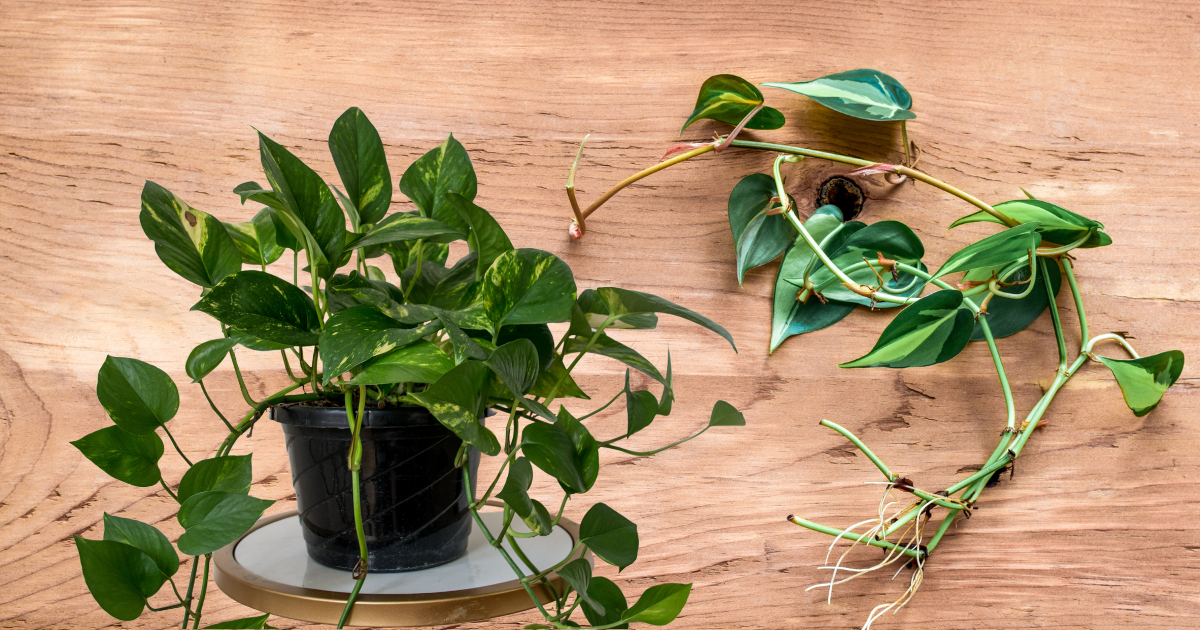Pothos plants are famous for their easy-care nature, trailing vines, and vibrant green leaves. However, even these low-maintenance plants require occasional pruning to stay healthy and look their best. If you’re new to plant care, you might wonder: How far can you trim a pothos plant without harming it? The good news is that pothos plants are resilient and can handle significant trimming. Whether you’re looking to shape your plant, control its size, or encourage bushier growth, knowing how much to cut is key to achieving your desired results.
In this guide, we’ll explore the best practices for pruning a pothos plant without causing damage. We’ll discuss how to identify the right spots for cutting, the factors influencing how much you can trim, and tips to ensure your pothos bounce back better than ever. By the end, you’ll be confident to give your pothos the perfect trim, helping them thrive in your space.
What is a Pothos Plant?

The pothos plant (Epipremnum aureum) is one of the most popular houseplants, celebrated for its low-maintenance care, attractive appearance, and hardiness. Also known as Devil’s Ivy, pothos is recognized by its heart-shaped leaves ranging from solid green to variegated patterns with yellow, white, or even pale green streaks. This tropical vine is native to Southeast Asia and thrives indoors, making it a favorite for beginner and seasoned plant enthusiasts.
Pothos is versatile and adaptable, capable of growing in various conditions, including low light and inconsistent watering. Its trailing vines can either be left to hang gracefully from a shelf or trained to climb, making it an excellent choice for different indoor settings. Besides its aesthetic appeal, pothos is also known for its air-purifying qualities, helping to remove toxins from the air. With its robust growth habit and forgiving nature, the pothos plant is a perfect option for anyone looking to add some greenery to their home with minimal effort.
Importance of Pruning for Pothos Health

- Promotes Fuller Growth: Regular pruning encourages your pothos to grow fuller and bushier by stimulating new shoots. When you trim the vines, the plant redirects energy to produce more leaves, resulting in a denser and healthier appearance.
- Controls Plant Size: Pothos can grow quickly and become long and leggy. Pruning helps control its size and shape, making it easier to maintain in your space. This is particularly important for those with limited room or who want a more compact plant.
- Prevents Leggy Growth: Pothos vines can develop long, bare stems with few leaves when left untrimmed. Pruning removes these leggy sections and encourages more leaf growth closer to the base of the plant, maintaining a balanced look.
- Removes Dead or Damaged Leaves: Regular pruning allows you to remove yellowing, dying, or damaged leaves. This improves the plant’s appearance and prevents potential diseases from spreading to healthy parts of the plant.
- Enhances Overall Health: By cutting back overgrown or crowded areas, you improve air circulation and light exposure, essential for the plant’s overall health and growth. A well-pruned pothos is less prone to pests and diseases, ensuring long-term vitality.
Why Pruning is Essential for Pothos Plants?
Promotes Healthier Growth
Pruning is crucial for the overall health of your pothos plant. Cutting back overgrown or unhealthy sections allows the plant to focus its energy on producing new, vibrant leaves and stems. Regular pruning helps remove any dead or dying parts, preventing the spread of disease and ensuring that the remaining healthy sections thrive. The plant responds by growing more vigorously, resulting in a fuller and more robust appearance.
Maintains the Desired Shape and Size
Pothos plants can grow rapidly, often sprawling out in various directions. Pruning allows you to control the shape and size of the plant, making it easier to fit into your space. Whether you prefer a compact, bushy look or longer trailing vines, trimming gives you the flexibility to create your desired aesthetic. You can keep your pothos neat and well-maintained by routinely cutting back overgrown areas.
Helps Control Leggy Growth
Over time, pothos vines can become leggy, with long stems and fewer leaves. This happens when the plant stretches out, often due to insufficient light. Pruning leggy growth encourages the plant to produce new leaves closer to the base, resulting in a fuller, more attractive appearance. Regular trimming helps maintain a balanced, lush look, making your pothos more visually appealing and healthy.
When is the Best Time to Trim Your Pothos?
Seasonal Considerations
The best time to trim your pothos plant is during the growing season, typically spring and summer. During these months, your plant is in an active growth phase and can quickly recover from pruning, producing new leaves and vines. While light trimming can be done year-round, avoid heavy pruning in the winter when the plant’s growth slows down. Pruning during dormancy can stress the plant and delay its recovery.
Signs Your Pothos Needs Pruning
Pruning isn’t only about timing; it’s also about responding to your plant’s needs. Key signs that your pothos is ready for trim include long, bare vines with few leaves, yellowing or wilting leaves, and overcrowded growth. If you notice these symptoms, it’s time to prune to keep your plant healthy and vibrant.
How Far to Trim a Pothos Plant
Trimming your pothos plant can significantly impact its growth and appearance. Knowing how far to cut is crucial for achieving a healthy, lush plant. Here’s a detailed guide on how to trim your pothos effectively:
General Rule of Thumb for Trimming
When it comes to trimming your pothos, a good rule of thumb is to remove no more than 25-30% of the plant’s foliage at a time. This ensures the plant retains enough leaves to continue photosynthesis and maintain health. Over-pruning can stress the plant, leading to slower recovery and potentially affecting its growth. Conversely, under-pruning might not achieve the desired look or health benefits. Regular, light trimming helps balance the plant’s growth and keeps it looking its best.
Understanding Node Locations and Leaf Spacing
Nodes are key to successful pruning and healthy growth. They are the points on the vine where leaves and roots emerge. When trimming, it’s essential to make cuts just above these nodes. This practice encourages new growth from the node, leading to a fuller and bushier plant.
- Locate the Nodes: Nodes are often visible as small bumps or ridges along the vine. The areas where leaves are attached or where aerial roots may appear.
- Cut Above the Node: Make your cut just above a node, exposing the node. This spot will produce new growth, producing a more compact and vigorous plant.
Leaf spacing is also important. Your plant may appear leggy and sparse if the leaves are too far apart. Regular pruning helps reduce the distance between leaves, promoting a fuller and more attractive appearance.
Factors That Determine How Much to Cut

Several factors influence how much you should trim your pothos plant:
- Growth Rate: Fast-growing pothos may require more frequent pruning to control their size and maintain their shape. If your plant proliferates and becomes unruly, trim it back more significantly.
- Plant Health: If your pothos have areas with yellowing or damaged leaves, trim these sections back to promote overall health. Removing unhealthy parts can help the plant redirect its energy to healthy growth.
- Desired Appearance: Consider the look you want to achieve. If you prefer a bushier appearance, trim long, leggy vines and cut above nodes to encourage new growth. Trim just enough to manage the length and shape for a trailing effect without disrupting the plant’s overall look.
- Season: During the growing season (spring and summer), pothos are more resilient and can handle more substantial pruning. In contrast, avoid heavy pruning during the dormant winter months, as the plant’s growth slows and recovery takes longer.
How Much Should You Trim a Pothos?
General Rule of Thumb for Pothos Pruning
When trimming your pothos, removing up to 25-30% of the plant at a time is generally safe. This amount ensures the plant retains enough foliage to continue photosynthesis while promoting fuller, bushier growth. Excessive trimming can shock the plant, so it’s best to prune conservatively if unsure.
How to Determine Which Vines to Cut
Removing Dead or Damaged Leaves
Start by removing any yellowing, wilted, or damaged leaves. These parts no longer benefit the plant and can attract pests or diseases. Make clean cuts at the base of these leaves to encourage new, healthy growth.
Managing Long or Leggy Vines
Next, focus on leggy vines that have stretched out with sparse leaves. These can be trimmed back to the nearest healthy node (the point where leaves grow). Cutting just above a node encourages new leaves and branches, resulting in a fuller plant. Feel free to trim back several inches for excessively long vines, especially if you want a more compact, bushy look. Regular pruning keeps your pothos looking their best and helps them stay healthy by directing energy toward producing strong, vibrant growth.
Step-by-Step Guide to Pruning Your Pothos
Pruning your pothos is a straightforward process that can make a big difference in the health and appearance of your plant. Whether you aim to control its size, shape it, or encourage bushier growth, following these steps will help you achieve the best results.
Tools You’ll Need
Before you begin, gather the right tools. The essentials include:
- Sharp, sterilized scissors or pruning shears: Clean tools ensure smooth cuts and reduce the risk of introducing diseases to your plant.
- Disinfectant or rubbing alcohol: Use this to sterilize your tools before and after pruning, significantly if you cut back damaged or diseased sections.
- A clean surface or container: Collect the trimmings for disposal or propagation.
Having the right tools ready makes the process smoother and ensures your plant remains healthy after pruning.
Preparing Your Pothos Plant for Pruning
- Inspect Your Plant: Before cutting, examine your pothos to identify areas that need trimming. Look for long, leggy vines, yellowing or damaged leaves, and overcrowded sections.
- Decide on the Shape: Determine whether you want to keep your pothos compact, encourage trailing vines, or promote fuller growth. Having a goal in mind will guide where and how much you trim.
- Sterilize Your Tools: Dip your scissors or shears in disinfectant to prevent the spread of any pathogens. This is especially important if you’re cutting off unhealthy parts.
Where to Make the Cuts
Once you’ve prepared your tools and assessed your plant, it’s time to make the cuts. Understanding where to trim is key to successful pruning.
Cutting Near the Node
Nodes are critical spots on your pothos where new leaves and roots emerge. They are usually located at the point where leaves connect to the vine. When pruning, always cut just above a node. This method encourages new growth from that spot and helps the plant develop more branches.
- Identify the Nodes: Locate the nodes along the vine. If you want to make the plant bushier, trim just above a healthy node. This encourages new stems and leaves to grow closer together, creating a fuller appearance.
- Make Clean, Angled Cuts: Use sharp shears to make a clean, angled cut. Angled cuts reduce the chance of water pooling on the cut surface, which can lead to rot.
Tips for Encouraging New Growth
After making your cuts, a few simple steps can encourage your pothos to grow back even better.
- Prune Regularly: Frequent light pruning is better than occasional heavy trimming. This keeps the plant in a continuous state of growth, resulting in a fuller and more vigorous plant over time.
- Proper Lighting: After pruning, place your pothos in bright, indirect light. Good light exposure supports new growth and helps the plant recover quickly.
- Water and Fertilize Appropriately: After pruning, ensure your plant gets the proper care. Keep the soil slightly moist but not soggy, and consider using a balanced liquid fertilizer during the growing season to provide extra nutrients.
- Pruning: your pothos is not just about removing unwanted parts; it’s an opportunity to shape and rejuvenate your plant. By making thoughtful cuts and providing the right care afterward, you can maintain a healthy, lush pothos that thrives in your space. Regular maintenance through pruning will ensure your plant remains vibrant, full, and ready to grow year-round.
How to Care for Your Pothos After Pruning

After you’ve pruned your pothos, proper post-pruning care is essential to ensure your plant recovers quickly and thrives. Here’s how to give your pothos the best care following a trim:
- Maintain Optimal Light Conditions: Place your pothos in bright, indirect light. This helps stimulate new growth and supports the plant’s recovery. Avoid direct sunlight, which can scorch the leaves, especially after pruning when the plant is more vulnerable.
- Watering: Adjust your watering routine to keep the soil consistently moist but not soggy. After pruning, the plant’s water needs might change slightly. Ensure the soil is well-drained and avoid letting it sit in excess water, which can lead to root rot.
- Fertilize: Consider using a balanced, liquid fertilizer once every 4-6 weeks during the growing season (spring and summer). This provides the necessary nutrients to support new growth and helps your pothos recover more quickly.
- Monitor for Pests and Diseases: Keep an eye on your plant for any signs of pests or diseases, especially after pruning. Regularly check the leaves and stems for any unusual spots or pests, and address any issues promptly to prevent problems from spreading.
- Humidity: Maintain a moderate level of humidity around your pothos. While pothos is relatively tolerant of varying humidity levels, higher humidity can help promote lush, healthy growth. You can increase humidity by misting the plant or using a humidity tray.
Common Pruning Mistakes to Avoid
Pruning can greatly benefit your pothos, but certain mistakes can hinder recovery and overall health. Here’s what to avoid:
Over-pruning or Under-pruning
- Over-pruning: Removing too much foliage at once can stress your pothos and hinder its recovery. Aim to trim no more than 25-30% of the plant’s foliage at a time. Over-pruning can lead to a sparse appearance and slow the plant’s regrowth.
- Under-pruning: On the other hand, neglecting to prune when needed can result in an overgrown, leggy plant. This can affect the plant’s appearance and health. Regular, light pruning helps maintain a balanced and vibrant pothos.
Cutting in the Wrong Places
- Avoid Cutting Too Close to the Base: Cutting too close to the base of the plant can damage the stem and inhibit new growth. Always trim just above a node to encourage healthy regrowth. Nodes are where new leaves and branches will emerge.
- Incorrect Node Cutting: Cutting at the wrong spot, such as away from the node, can result in less effective pruning and a less desirable growth pattern. Ensure to cut just above a node to promote new shoots and a fuller plant.
Tips for Pruning and Caring for Your Pothos
- Use Sharp, Clean Tools: Always use sharp, sterilized scissors or pruning shears to make clean cuts. This helps prevent damage to the plant and reduces the risk of spreading diseases.
- Prune During the Growing Season: Prune your pothos during the growing season (spring and summer) for best results. The plant is more resilient and will recover faster from pruning during this time.
- Remove Only What’s Necessary: Trim only the overgrown or damaged sections of your plant. Avoid excessive cutting, which can stress the plant and slow its recovery.
- Cut Above the Node: To promote new growth, always make cuts just above a node (the point where leaves attach to the vine). This encourages the plant to produce new shoots from that area.
- Monitor Light Conditions: After pruning, ensure your pothos receive adequate, bright, indirect light. Good lighting supports new growth and helps the plant recover more quickly.
- Water Properly: Keep the soil consistently moist but not soggy. Overwatering or letting the plant dry out can ultimately affect its recovery and overall health.
- Consider Propagation: Use the cuttings from pruning for propagation. This is a great way to expand your plant collection or share with friends, ensuring that no part of the plant goes to waste.
- Fertilize Wisely: Apply a balanced, liquid fertilizer during the growing season to support new growth. Avoid over-fertilizing, as this can lead to nutrient imbalances and plant stress.
- Regularly Check for Pests: After pruning, look for pests and diseases. Pruning can sometimes expose previously hidden issues, so regular inspections help keep your plant healthy.
- Be Patient. Plants need time to recover and grow after pruning. Give your pothos the time it needs to bounce back and thrive.
FAQs
How often should I prune my pothos plant?
Pruning your pothos plant every 6-8 weeks during the growing season is ideal. Regular light pruning helps maintain its shape, encourages bushier growth, and prevents it from becoming leggy. If you notice overgrowth or unhealthy sections outside this schedule, you can trim as needed.
Can I propagate my pothos from the cuttings I trim?
Yes, pothos cuttings are excellent for propagation. Take cuttings with at least one node, place them in water or soil, and they will develop roots over time. This is a great way to expand your plant collection or share with friends.
What should I do if I accidentally cut too much off my pothos?
If you accidentally trim too much, don’t worry. Your pothos can recover, but it might take some time. Ensure the plant receives proper care with adequate light, moisture, and occasional feeding to support new growth. Avoid further heavy pruning until the plant has bounced back.
How can I tell if my pothos need pruning?
Look for signs like long, leggy vines with sparse leaves, yellowing or damaged foliage, and overcrowded growth. These indicators suggest that pruning is needed to promote healthier growth and improve the plant’s appearance.
Should I sterilize my pruning tools?
Yes, always sterilize your pruning tools before and after use. This prevents the spread of diseases and pests between plants. Use disinfectant or rubbing alcohol to clean the tools and ensure smooth, healthy cuts.
Conclusion
Pruning your pothos is essential for maintaining a healthy, vibrant plant. Following proper techniques and understanding how much to cut can encourage bushier growth, prevent leggy vines, and keep your pothos looking their best. Regular pruning, along with careful post-pruning care, ensures your plant remains lush and attractive. Use clean, sharp tools and cut just above nodes to foster new growth. With these practices, your pothos will thrive and enhance your indoor space beautifully.







